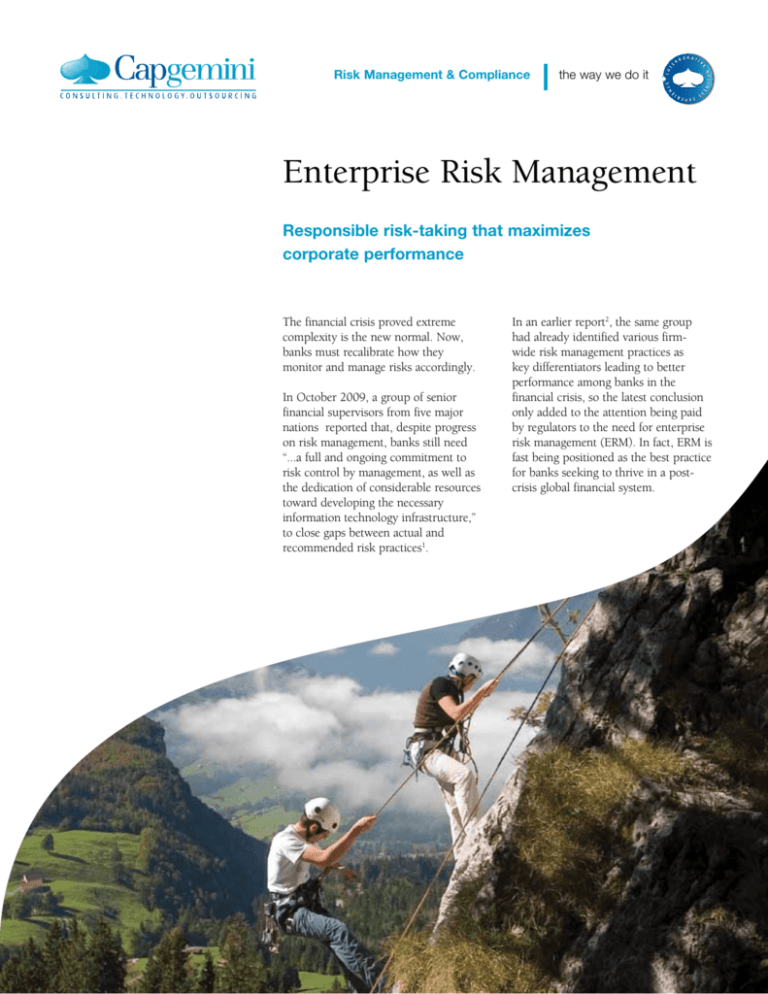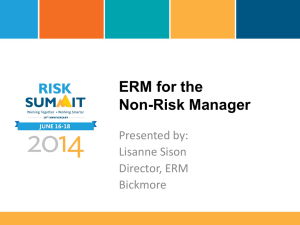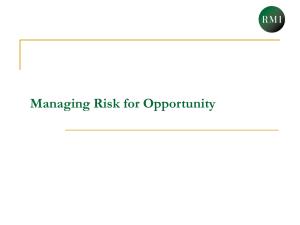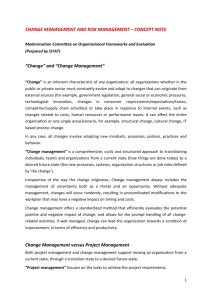
Risk Management & Compliance
the way we do it
Enterprise Risk Management
Responsible risk-taking that maximizes
corporate performance
The financial crisis proved extreme
complexity is the new normal. Now,
banks must recalibrate how they
monitor and manage risks accordingly.
In October 2009, a group of senior
financial supervisors from five major
nations reported that, despite progress
on risk management, banks still need
“...a full and ongoing commitment to
risk control by management, as well as
the dedication of considerable resources
toward developing the necessary
information technology infrastructure,”
to close gaps between actual and
recommended risk practices1.
In an earlier report2, the same group
had already identified various firmwide risk management practices as
key differentiators leading to better
performance among banks in the
financial crisis, so the latest conclusion
only added to the attention being paid
by regulators to the need for enterprise
risk management (ERM). In fact, ERM is
fast being positioned as the best practice
for banks seeking to thrive in a postcrisis global financial system.
ERM Practitioners Had an Edge in the Crisis
Enterprise risk management practices were cited as a key differentiator by the Senior
Supervisors Group* in its 2008 report Observations on Risk Management Practices during
the Recent Market Turbulence.
Firms that “demonstrated a comprehensive approach to viewing firm-wide exposures and
risk, sharing quantitative and qualitative information more effectively across the firm and
engaging in more effective dialogue across the management team” tended to deal more
successfully with the ongoing market turmoil (at least up to that point), said the group.
More specifically, the Senior Supervisors Group said four firm-wide risk management
practices differentiated better performance from worse among banks in the financial crisis.
Those four practices are:
Effective firm-wide risk identification and analysis,
■
Consistent application of independent and rigorous valuation practices across the firm,
■
Effective management of funding liquidity, capital, and the balance sheet,
■
Informative and responsive risk measurement and management reporting.
In the past, credit and market risk were
certainly less interrelated, with a crisis
in one sector at times spilling over
into another but rarely undermining
multiple segments simultaneously. The
most recent financial crisis changed
all that. Instead, the recent crisis was
marked by the contagion effect among
interdependent markets and players.
Simple risk-diversification strategies often
did little to mitigate losses, and certain
products—such as derivatives like credit
default swaps—relied on such a complex
and interrelated web of counterparties
that all parties suffered when conditions
changed for underlying products.
■
* The Senior Supervisors Group consists of 10 agencies representing 7 countries.
U.S. Federal Reserve Board Chairman
Ben S. Bernanke has publicly stated that
“...policymakers must insist that the
large financial firms they supervise be
capable of monitoring and managing
their risks in a timely manner and on an
enterprise-wide basis.3”
ERM is a Must Given the Evolution
of Financial Markets and Risk
The financial crisis demonstrated exactly
how complex and interrelated risks
had become—and how ill-prepared
many banks were to monitor their own
exposures, especially across the firm.
Given the changing shape of global
finance, it is perhaps not surprising that
day-to-day risk-management practices
have failed to keep pace. Unless your
bank takes to heart the lessons learned
from this financial crisis, it will be illprepared for the next.
ERM can provide your bank with the
capabilities needed to:
Accurately map and monitor the
different dimensions of risk and
returns across your entire organization
■ Establish accountability for those risks/
returns; and
■ Institutionalize a risk appetite that
provides your firm with a consistent
prism through which to pursue
profitable and ‘opportunistic’ risks and
avert hidden threats.
■
1
Risk Management Lessons from the Global Banking Crisis of 2008, Senior Supervisors Group (SSG), October 21, 2009
2
Observations on Risk Management Practices during the Recent Market Turbulence, Senior Supervisors Group, March 6, 2008
3
Financial Reform to Address Systemic Risk, Ben S. Bernanke, Speech to the Council on Foreign Relations, March 10, 2009
Risk Management & Compliance
Your bank needs a degree of risk insight
that can only be achieved via ERM to
operate profitably in today’s complex
global markets. In fact, without ERM,
it will be increasingly difficult for your
bank to retain a competitive edge,
return value to shareholders, or adapt
to shifting demands around high-profile
issues like compensation practices.
Addressing Today’s Risk
Imperatives
In the face of the market and regulatory
realities, the case for ERM seems
overwhelming, but the evolving risk
landscape has clearly created enormous
challenges for Chief Financial Officers
(CFOs) and Chief Risk Officers
(CROs) who must manage the actual
implementation of new risk systems or
recalibrate existing ones.
There are numerous strategic issues
keeping bank CFOs and CROs awake at
night, but underlying almost all of those
concerns lies fundamental challenges
in addressing issues of information
transparency and data strategy.
Regardless of whether your bank has an
enterprise risk system in place, you still
need to:
the way we do it
Achieve greater transparency, which
requires a foundation of enterprise risk
information;
■ Elevate risk-data governance to a
strategic business objective;
■ Institutionalize integrated, reliable
risk applications at all levels of
management.
■
These three initiatives form critical
building blocks in a sound ERM
approach. Without them any ERM
approach would be hard-pressed
to either mitigate risk or maximize
opportunity in today’s complex
operating environment.
With a robust, integrated data strategy,
your bank will be better positioned
to establish an enterprise view of
risks so you can view, and actively
monitor, exposures across businesses,
counterparties and risk dimensions. This
picture lets your bank extract maximum
value from each of the risks you take
on, identify the degree to which any risk
exposure needs to be actively managed,
and spot concentrations and other
high-risk exposures that exist or could
emerge as circumstances change.
6 Key Data-Related Risk Challenges
Among the top data-related challenges for many banks:
1.
Data is trapped in silos, e.g., after M&A, hiding firm-wide risk accumulations (and
potential portfolio off-sets).
2.
Inconsistent valuations and reference data exist across different parts of the firm.
3.
Few standards have been established for data (e.g., Are there clearly defined
definitions/standards for risks/risk types?)
4.
Data-governance models are often inadequate (e.g., Who owns data and updates?
Who verifies data? What policies ensure adherence to protocols?)
5.
Risk systems do not allow for proper analysis of firm-wide exposure across risk
dimensions, counterparties, etc.
6.
Models generate incorrect forecasting of potential outcomes (e.g., models are too
backward-looking and not dynamic enough).
Capgemini’s Solutions to Address
Risk & Market Challenges
Capgemini offers solutions for Enterprise
Risk Management that give your bank
the tools and frameworks you need
to optimize your risk management
capabilities and integrate risk
management framework into strategic
decision-making processes.
Our risk management offerings focus
on developing a more integrated,
transparent and predictable risk
framework. Capgemini’s Enterprise
Risk Framework is highly flexible
and outlines a set of risk management
practices that can be fully adopted
or adapted to your existing risk
framework. Capgemini’s solutions can
be implemented as individual modules
or an end-to-end package to:
Assess and analyze your firm’s existing
Enterprise Risk Model;
■ Develop your Enterprise Risk
Management Strategy covering key
areas such as loss forecasting, credit
risk scoring models and reference
data & semantics;
■
Identify and support Information
Strategy & Architecture, Governance
& Metadata, Customer Data
Integration and Master Data
Management;
■ Build custom-tailored ERM
Dashboards and Reporting solutions
for a holistic and comprehensive view
of risk exposures, including market
risk models and methodologies and
integrated forecasting;
■ Perform software selection,
implementation and application
support for Enterprise Risk
Management package solutions
featuring vendor partnerships with
IBM, SAS, Oracle, Fermat, SunGard,
Oracle and FinArch.
■
Capgemini also understands that
especially during tough times, financial
services organizations need quick returns
with minimal investment. Based on
our experience with large global banks,
Capgemini developed two highly focused
solutions for enterprise risk management
that bring quick benefits while also
helping banks establish a roadmap for
a longer-term ERM program.
Risk Management & Compliance
Capgemini’s Sigma Map™ lets you map risk types to the balance sheet
Assets
Balance Sheet
Market
Risk
Operational
Risk
Contagion
Risk
Liquidity
Risk
Reputation
Risk
Loans &
Leases
Securities
Govt. Funds
& Repos
Borrowings
Subordinate
Notes
Equity
At the end of our assessment, Capgemini
will deliver:
An assessment of models for credit,
market and operational risk;
■ An evaluation of your Basel II
preparedness, IT architecture and
organizational structure as it relates
to risk;
■ A future-state roadmap for enterprise
risk management.
Credit
Risk
Deposits
Liabilities
Enterprise Risk Maturity
Assessment: Learn Where
You Stand
With our proprietary Maturity
Assessment model, Capgemini can help
you assess and analyze your bank’s
current risk frameworks, including
those for credit and operational risk.
The assessment provides your firm
with an understanding of where you
stand compared with industry best
practices, regulatory standards and
recommendations, and gauges the
degree to which your existing data
infrastructures are adequate and scalable
enough for future ERM needs.
the way we do it
Economic Capital Measures
■
Enterprise Risk Dashboard: See
the Whole Picture
For effective enterprise risk
management, your bank needs a
clear understanding of the complete
risk exposure and the impact of your
exposure on stock price valuations.
Capgemini’s proprietary Sigma Map™
framework lets your bank capture an
enterprise-wide view of risk positions
across critical business dimensions so
you can proactively manage and control
the entire risk profile. Through Sigma
Map™, we can help you map the
balance sheet to risk types and measure
the combined impact on stock price.
Capgemini can help your firm develop
an enterprise risk dashboard that:
Presents a holistic view of all risk types
faced by your organization;
■ Defines the risk/return trade-offs using
best-in-class Key Risk Indicators;
■ Integrates reference and market data
benchmark performance;
■ Lets you review changes in exposures
and evaluate the potential impact on
capital allocation;
■ Provides a wealth of different reports;
■ Supports loss forecasting and scenario
& trend analysis.
■
Using our real-world experience
implementing risk management
dashboards for top 10 banks in the
US and across the globe, Capgemini’s
ERD is built on a proprietary Portfolio
Reporting Framework that leverages
our extensive experience. We can help
your bank implement dashboards using
your own data in a Capgemini-hosted
environment or entirely within your
own infrastructure.
What Makes Capgemini Different?
Capgemini is a proven and trusted
partner for providing enterprise risk
management and compliance solutions
and is currently assisting many of the
world’s large banking organizations in
their ERM initiatives. Here are few of
the reasons Capgemini is preferred by
our clients.
exposure to the balance sheet. We fully
integrate different risk components
into one enterprise view with our ERM
Dashboard and have developed a proven
risk- specific data mart which is based
on risk management principles and
critical factors most relevant for risk
officers and Boards of Directors.
Highly Qualified Risk Professionals
We have a highly experienced and
certified network of over 400 risk
professionals who have executed more
than 100 Basel projects and 500 risk and
compliance projects in the last two years.
Quick Wins to Support Your
Risk Initiatives
Our approach to ERM helps your
bank gain substantial benefits with
minimal investment. Projects like ERM
Assessments and Dashboards result
in measurable benefits in a very short
timeframe and can help you build
a business case for long-term ERM
initiatives. Benefits include:
Capgemini’s risk professionals have
years of experience developing credit
risk models and profiles, implementing
Basel II standards, estimating the risk
parameters for capital calculations,
and maintaining economic capital
models, including Moody’s, PM
and RAROC tools.
Sigma Map™ and ERM Maturity
Framework
Capgemini’s expertise in risk
management is substantiated through
our proven ERM Maturity Framework
and Sigma Map™ methodology
which helps you match your risk
■
■
Financial benefits. Our ERM insights
help your whole organization better
correlate corporate performance to
risk exposure, improve decisions on
investment and capital allocation, and
identify risk opportunities that could
be used for competitive advantage.
Operational benefits: Since ERM
provides an effective framework for
linking strategic goals to operational
plans, Capgemini can help optimize
your operations around a consistent
Unparalleled risk knowledge & expertise
Unmatched IP with over 74 risk and compliance assets including proprietary tools and
methodologies spanning all critical risk dimensions
■
Proprietary methodology and tools for stress testing, loss forecasting, economic capital,
risk scorecards, RAROC proprietary algorithms and risk data marts
■
Pre-fabricated ETL codes to pull data from key loan origination systems for accelerated
implementations
■
In-house economic capital simulation engine
■
Reusable regulatory capital calculator and regulatory spreadsheets
■
True enterprise risk view with integrated forecasting
■
Risk Management & Compliance
view of risk appetite and exposures
and offer a single vantage point
through which risk appetite is
discussed, communicated and
integrated firm-wide into business lines
and decisions.
■
Shareholder benefits. As your finances
and operations improve, shareholders
and other stakeholders can gain
confidence from increased visibility
and transparency into your bank’s risk,
possibly improving your bank’s ability
to compete for investor capital.
Reduction in Compliance and
Risk Management Costs
Capgemini’s ERM solutions help your
bank reduce the operational costs you
would otherwise incur in maintaining
redundant and disparate risk databases.
the way we do it
By consolidating enterprise risk data
in a single information system, your
bank can reduce overhead costs of data
collection by different business units
or divisions. We leverage risk projects
for assessing compliance preparedness,
thereby reducing the cost of compliance
projects.
Comprehensive Risk Offerings
Capgemini is one of the only risk
management consultancies offering full
end-to-end risk management services.
Implemented independently or as
part of a Risk Management strategy,
Capgemini’s highly flexible ERM and
ERD solutions help you achieve quick
returns while supporting your bank’s
long-term ERM initiatives.
Capgemini provides end-to-end support for Enterprise Risk Management initiatives
Risk Management
Regulatory Compliance
Data Management
Analytic Services
Enterprise Risk Management (ERM)
Basel II
Business Information
Strategy, Architecture &
Assessment
Modeling Services
ERM Assessment and Dashboard
■
GRC Applications Support
■
■
■
Compliance Assessment
Training
Compliance Support
■
Credit Risk (CR)
CR Framework and Assessment
■
CR Scoring Models and Reporting
Software Selection &
Integration
■
Mortgage Loss Forecasting
Awareness/Training
■
Market Risk (MR)
Reference Data & Semantics
■
Enterprise Models & Methodologies
■
Analytics Models & Methods
■
Information Strategy & Architecture
■
Governance & Metadata
Impact Analyses
■
SEPA
Impact Analyses
■
Strategic Analysis
■
Compliance Support
■
Operational Risk (OR)
OR Assessment and Management
■
Software Solutions
■
EC Framework
Compliance, Risk
■
Investment
■
Data Governance &
Stewardship
Compliance & Data Privacy
Data Classification
■
Data Cleansing
■
PSD Business Impact
Analysis
Economic Capital (EC)
■
Software Selection &
Integration
■
Fraud Detection
Customer, Product
■
■
Customer Data Integration & Master
Data
Master Data Management
Data Collection/Readiness
■
Stress Testing
Competitor Benchmarking
Metadata Management
■
■
Profitability Analysis
■
Warehousing
Reporting
Solvency II
Loss Forecasting
■
■
■
■
■
Information Management &
Data Integration
Predictive Modeling Model
Validation
■
Risk Adjusted Return On Capital
www.capgemini.com/financialservices
In Practice: Capgemini’s has world class experience delivering ERM solutions for financial services firms
Collections Reporting
Solution for a large
U.S. bank
The bank had disjointed Collections reporting and analysis capabilities populated using labor-intensive daily
processes. Capgemini provided a solution that served as the foundation for trending and analytical reporting
including the preservation of history for year-over-year comparisons and economic cycle forecasting.
Risk Management
Solution for a global
bank
One of the largest banking and financial services organizations in the world was experiencing difficulties with
the risk reporting due to multiple sources of risk data which created problems in developing correct and on time
credit information. Capgemini developed a risk management solution to further develop, leverage and exceed peer
competencies and more fully develop Basel II relevant metrics, analysis and reports.
Credit Risk Data
Mart for a large U.S.
financial holding
company
The financial holding company needed an integrated and centralized data management and reporting system to
address redundant and conflicting loan information between reports, get consistent monthly snapshots of the
state of business and integrate data between sources. Capgemini built a single repository to perform credit risk
management analytics on the commercial and retail loan portfolios.
Credit Risk
Monitoring for one of
the world’s largest
financial firms
Our client needed to frequently monitor credit portfolios to provide pertinent information to senior management to
include in the capital management process. Capgemini developed a Default Loss Data Repository (DLDR) of long
term history of default/loss experience to report, refine, calibrate PD and LGD estimates and delivered to an efficient
framework for ad-hoc queries and analysis reporting.
For more information, visit
www.capgemini.com/risk or email
riskandcompliance.fsgbu@capgemini.com
About Capgemini and the
Collaborative Business Experience
Capgemini, one of
the world’s foremost
providers of Consulting, Technology
and Outsourcing services, has a unique
way of working with its clients, called
the Collaborative Business Experience.
focused methods and tools. Capgemini
utilizes a global delivery model called
Rightshore® which aims to offer the
right resources in the right location at
competitive cost, helping businesses
thrive through the power of collaboration.
Backed by over three decades of industry
and service experience, the Collaborative
Business Experience is designed to help
our clients achieve better, faster, more
sustainable results through seamless
access to our network of world-leading
technology partners and collaboration-
Capgemini employs approximately
92,000 people worldwide and reported
2008 global revenues of 8.7 billion euros.
More information about our services,
offices and research is available at
FS201001070628CS
www.capgemini.com.
Copyright © 2009 Capgemini. All rights reserved.










